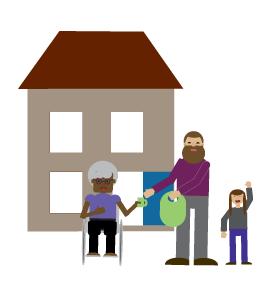- New models of care and support with accommodation
Shared Lives Plus Community alternative to residential care
What is the problem this innovation solves?
With nearly three million people living with three or more long-term health conditions by 2020, people need care and support which is personal, built around their friends and family networks and builds strong communities.
Traditional care can be inconsistent, prevent people from staying in a family home, doing things they love, with people they know. People with long-term health or care needs are typically offered either nothing, a crisis-only response, or a medicalised response which ignores or undermines their own capacity and resilience along with that of their families and social networks.
Solution
In Shared Lives, a young person or adult who needs support is matched with a carefully approved Shared Lives carer. Together, they share family and community life. Half of the people using Shared Lives live with their Shared Lives carer, sometimes for many years. The other half visit their Shared Lives carer for day support or overnight breaks.
Shared Lives can be a stepping stone for someone to get their own place, a way for people to leave hospital, before returning home, and prevents older people moving into a care home too early. Shared Lives is used by people with learning disabilities, people with mental health problems, older people, care leavers, young disabled adults, parents with learning disabilities and their children, people who misuse substances, and offenders.
Evidence base
Shared Lives consistently outperforms all other forms of regulated care in CQC inspections, at 92% good or excellent. An independent report by Social Finance showed that Shared Lives costs £26,000 less per year for people with learning disabilities than other forms of regulated care (£8,000 less for people with mental health problems). Kent University and others have found positive outcomes, and there is now a national outcome-measuring tool in use.
Expected impact
Shared Lives enables people with significant support or health needs to live well in a supportive household in the community of their choice.
The data up until April 2019 showed:
- 97% people in Shared Lives felt they were part of the family most or all of the time.
- 89% people felt that their Shared Lives carer’s support improved their social life.
- 85% people felt that their Shared Lives carer’s support made it easier for them to have friends.
- 89% people in Shared Lives felt involved with their community.
- 86% felt their Shared Lives carer’s support helped them have more choice in their daily life.
- 83% and 88% people felt their physical and emotional health had improved respectively.
Stage/spread (where it is/how much is there?)
There are over 10,000 Shared Lives carers. They are all approved following rigorous recruitment and training by one of the UK’s 150+ local schemes, regulated by the government’s care inspectors. Almost every area has a scheme, although some are small. Shared Lives has grown 30% in five years, now supporting nearly 14,000 people across the UK.
What would councils/local areas need to do or have in place to enable it to happen?
A wellresourced, supported and networked CQC-registered Shared Lives scheme, with support from the national membership network.
What would kill it?
Over- or under-regulation: a careful balance is needed between infrastructure and autonomy. Price cuts or corner-cutting would prevent Shared Lives from delivering stability, outcomes or savings.
Where to go for more information
The national body for Shared Lives is Shared Lives Plus. They offer membership support to local Shared Lives organisations and individual Shared Lives carers, as well as strategic support to commissioners.

